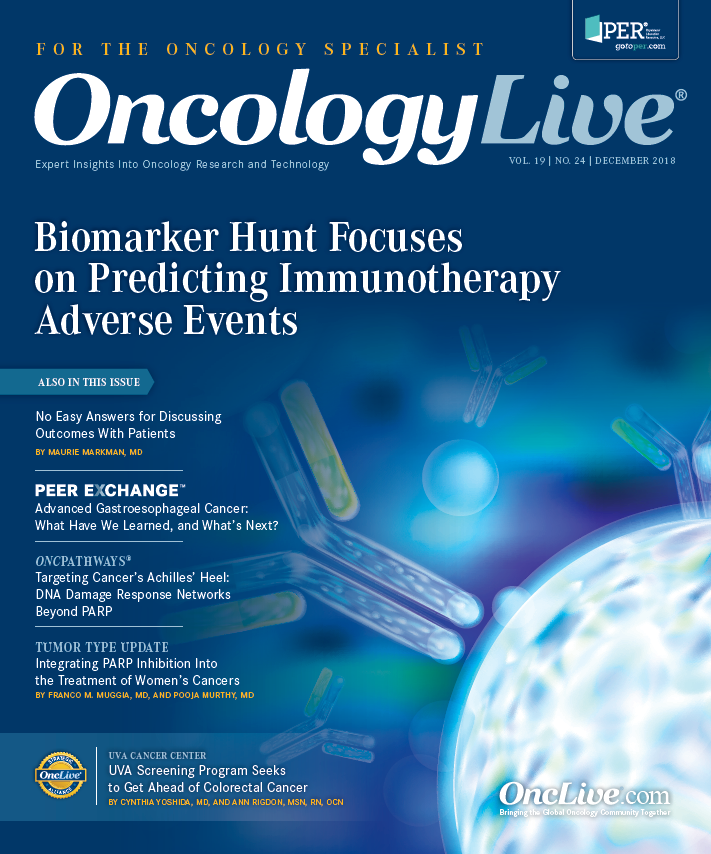Publication
Article
Oncology Live®
UVA Screening Program Seeks to Get Ahead of Colorectal Cancer
Author(s):
Approximately 1 of every 20 Americans will be diagnosed with colorectal cancer at some point in their life, and the American Cancer Society estimates that most colorectal cancer deaths can be prevented by screening.

Cynthia Yoshida, MD
Gastroenterologist
Digestive Health Center
University of Virginia Health System
Charlottesville, Virginia
The National Colorectal Cancer Roundtable’s 80% by 2018 initiative has been publicized for several years as a commitment to improving colorectal cancer (CRC) screening rates among adults 50 years and older, and this initiative will continue beyond 2018. Approximately 1 of every 20 Americans will be diagnosed with CRC at some point in their life, and the American Cancer Society estimates that most CRC deaths can be prevented by screening. Screening has been shown to save lives both by decreasing the incidence of CRC via the detection and removal of precancerous polyps and by increasing the likelihood of survival, which involves identifying CRC at an earlier stage when treatment is usually more effective.
Increase CRC Awareness
CRC screening is cost-effective. For the cost of treating 1 case of advanced CRC, hundreds or even thousands of people could be screened for this disease type. Screening for CRC is obviously the right thing to do, yet locally and nationally we are not meeting this goal. Improving the screening rate has been challenging for many organizations, including the University of Virginia (UVA). Why does something that sounds so simple require so much effort, and what makes that effort worthwhile?As a nationally ranked health system that includes a National Cancer Institute—designated cancer center, the UVA Health System is committed to leading in this arena through the development and implementation of a robust CRC screening program. Our vision is a system that allows us to (1) consistently offer patients appropriate options for CRC screening, (2) educate patients and providers about CRC screening, (3) remove barriers to screening, and (4) ensure that patients are supported appropriately after screening occurs.
The logical place to begin was to determine which screening methods to include within our program. The American Cancer Society recognizes 6 different options for CRC screening. Offering patients different test options significantly increases adherence to CRC screening recommendations. A review of outcomes, risks, costs, and benefits of all screening methods led to our decision to build our program around 4 tests: fecal immunochemical (FIT), colonoscopy, computed tomography colonography, and multitarget stool DNA.
To increase awareness, our goal was to educate both patients and providers about the options for CRC screening, with an emphasis on informed and shared decision making. We created patient-friendly literature to educate patients on specific test options and the lifesaving benefits of CRC screening. These materials are available in print form, on our website, and through our electronic health record (EHR), to provide easy access for our patients and providers.
Making Screenings More Accessible
Future Steps and Conclusions
To further educate providers in our state, UVA Health System is partnering with the American Cancer Society to create a webinar focused on a review of the current guidelines and the pros and cons of various CRC screening options. The literature validates that education alone will not result in improved screening rates. Logistical and systems-based obstacles must be identified and reduced to realize a consistently effective program. Within our institution, we have identified several important barriers. These include variability in the use of the EHR and health maintenance tabs among different offices and specialties, prioritization and time constraints that prevent consistent discussion of CRC screening between the primary care provider (PCP) and the patient, lack of clarity about ordering specific screening tests, and absence of processes to ensure that ordered screening tests are completed.Over the past year at UVA Health System, we have formed a multidisciplinary team to coordinate and support removal of these barriers, one by one. Physician and nursing leaders from our Cancer Center and Digestive Health, Radiology, and Primary Care departments formed a CRC screening steering committee with multiple projects aimed at addressing specific process gaps. Our initiatives include using the EHR to better identify unscreened patients; managing screening intervals using health maintenance tools; developing 1-stop referral access for CRC screening order sets that include all screening modalities, to ease the administrative burden on PCPs and creating standard processes to follow up on positive screening tests.As further evidence of the institutional commitment to this mission, UVA recently hired a CRC screening navigator who is an integral member of our team. She met with members from each specialty to understand and optimize the processes involved in ordering, performing, and following up on each CRC screening test. She developed several initiatives at our institution, including an annual FluFIT program, which combines flu shots with CRC screening promotions; a service line competition for CRC screening; and special March Colorectal Cancer Awareness Month activities. In addition, she actively promotes CRC screening at community health-focused events and has provided education and outreach to large area employers. As our CRC screening program expands, we plan to enhance patient-specific navigation by assisting with scheduling screening tests, reminding patients of their next screening interval, and initiating consults with colorectal surgeons and oncologists.
Although the initiatives mentioned above focus on improving screening for the population in the UVA Health System, there are other significant barriers to CRC screening in our region and state. These include lack of health insurance, poor access to regular-care providers, remote geographic locations, and educational and cultural barriers. Uninsured and underserved populations deserve special attention within a CRC screening program because failure to screen will result in a higher incidence of advanced CRC in these groups. Our strategies to reach these individuals include seeking grants to financially support affordable, simple, accessible FIT screening; partnering with regional organizations that serve specific uninsured and underserved communities; and uniting with other healthcare institutions to create pathways to screening.
Screening for CRC is an obvious need, but it requires a strategic plan to be successful. What is your organization doing to improve CRC screening rates? By asking that simple question, you can start the process to save lives.










